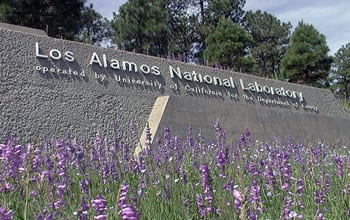
The National Nuclear Security Administration (NNSA) on Monday broke down how much of its requested $16.5 billion budget for fiscal 2020 would go to each of its nuclear-weapon labs. However, the Department of Energy branch had not still published its detailed 2020 budget request at deadline Friday for Nuclear Security & Deterrence Monitor.
The Energy Department did not reply to a request for comment about the timing for release of the detailed budget. However, Energy Secretary Rick Perry is slated to testify on the agency’s 2020 request Tuesday morning before the House Appropriations energy and water development subcommittee.
The Los Alamos National Laboratory in New Mexico stayed in the top spot, with a proposed budget of about $2.5 billion starting Oct. 1, or 1.5 percent above the 2019 appropriation, according to DOE’s preliminary laboratory tables. Los Alamos is the lead design laboratory for the B61-12 life-extension program, which began in earnest in December when the Y-12 National Security Complex in Tennessee cranked out the first secondary stage for the refurbished gravity bomb.
Including Air Force and NNSA work, the B61-12 and its new guided tail kit will cost between $11.5 billion and $13 billion over about 20 years, according to NNSA and Pentagon documents. The NNSA’s share of the work comes to a little more than $8 billion, the agency estimated in its 2019 Stockpile Stewardship and Management Plan.
The nonprofit Federation of American Scientists estimates the NNSA will build some 480 B61-12 bombs.
Los Alamos is also expanding its capacity to produce fissile warhead cores called plutonium pits with 2020 funding under the previously authorized Chemistry and Metallurgy Research Replacement project. The NNSA has not yet said exactly how much funding the pit expansion in New Mexico will receive. In the now-year-old 2019 budget request, it projected the project would need about $240 million for fiscal 2020.
Los Alamos is on the hook to make at least 30 war-usable pits annually beginning in 2026, if not sooner.
The Sandia National Laboratories, headquartered in Albuquerque and with a satellite location in California, would get about $2.4 billion for 2020, which is about 4.5 percent, or around $100 million, more than the 2019 appropriation of roughly $2.3 billion. The lab designs the non-nuclear components of nuclear weapons.
The Lawrence Livermore National Laboratory in California would get the largest proportional budget increase in 2020, if the NNSA’s request became law. The agency seeks about $1.8 billion, which is more than 17.5 percent, or $280 roughly million, above the 2019 appropriation of $1.5 billion.
Livermore is leading the W80-4 life-extension program to modernize the warhead slated to top the Pentagon’s new nuclear-tipped, air-launched cruise missile, the Long-Range Standoff weapon.
The Department of Defense plans to deploy the missile in the late 2020s to replace the Air-Launched Cruise Missile tipped with the W80-1 warhead. Livermore’s life-extension is set to ramp up significantly in the coming fiscal year.
The W80-4 has a budget of about $655 million in fiscal 2019, which is about 65 percent, or $255 million, more than the 2018 appropriation of roughly $400 million. In its 2019 budget request last year, NNSA estimated it would seek more than $710 million for W80-4 for 2020.
Overall, the NNSA seeks $16.5 billion for fiscal year 2020, compared with a 2019 appropriation of just over $15 billion.
The laboratory weapon funding comes mostly from the NNSA’s Directed Stockpile Work account, for which the agency seeks about $5.4 billion for the next budget year that. That is around 16.5 percent, or almost $770 million, higher than the 2019 appropriation of roughly $4.65 billion, according to the latest edition of DOE’s annual budget in brief.
Within Directed Stockpile Work will be funding to “sustain” the B83 megaton-class nuclear gravity bomb, which the Donald Trump administration has decided to keep in the arsenal, reversing the Barack Obama administration’s decision to retire the weapon.
Meanwhile, the budget in brief provided top-level funding requests for NNSA’s non-lab production and test sites for fiscal 2020. These include:
- The Y-12 National Security Complex, Oak Ridge, Tenn. Roughly $1.9 billion: a little more than 4 percent, or about $80 million, over the 2019 appropriation of roughly $1.8 billion.
- The Pantex weapons assembly and disassembly plant, Amarillo, Texas. About $959 million: more than 16 percent, or around $135 million, above the 2019 appropriation of some $825 million.
- The Kansas City National Security Campus, Kansas City, Mo. For the manufacturer of the non-nuclear components of nuclear weapons, a little more than $995 million. That is the largest proportional increase of any major site in the nuclear-security enterprise at about 30 percent, year over year. Kansas City had a roughly $750 million appropriation for 2019, or around $240 million less than the NNSA request for 2020.
- The Nevada National Security Site. Around $495 million, or about 27.5 percent, above the 2019 budget of almost $390 million.
The DOE’s annual laboratory budget tables do not break out the value of NNSA tritium processing and defense nuclear nonproliferation work at the Savannah River Site in Aiken, S.C.
However, NNSA has also proposed spending $220 million, in line with the 2019 budget, to continue shutting down the Mixed Oxide Fuel Fabrication Facility (MFFF) at Savannah River. The agency wants to turn that plutonium disposal plant, which it canceled in October, into a factory that can by 2030 annually produce 50 fissile warhead cores called plutonium pits.
To get rid of the 34 metric tons of surplus plutonium the MFFF would have turned into commercial reactor fuel, the NNSA has proposed spending $79 million on a new Savannah River Site dilute-and-dispose program.